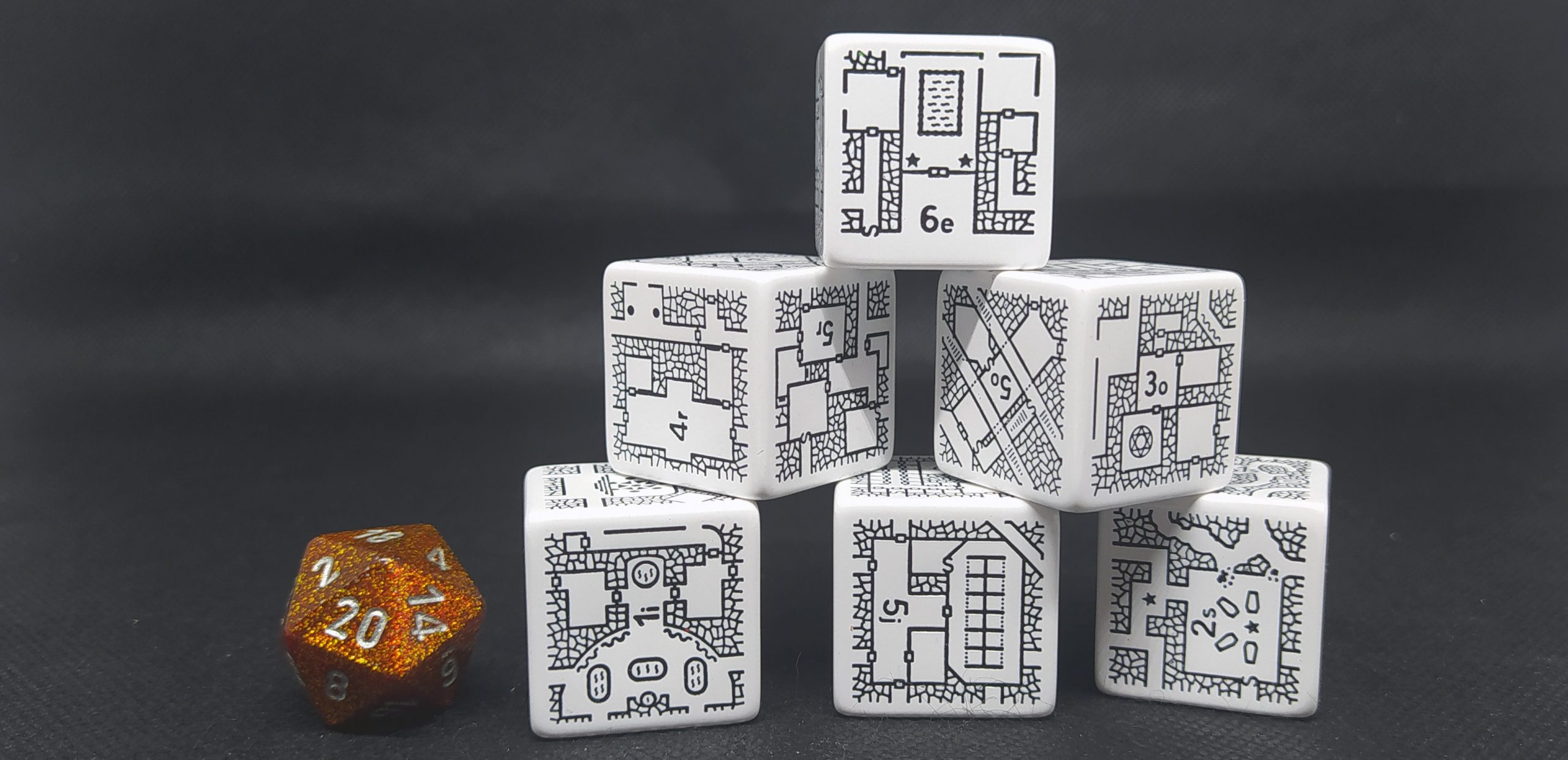We thank Inkwell Ideas for sending us an example of Dungeonmorph Dice e one of Dungeonmorph Cards to write this review.
The first product, Dungeonmorph Dice, produces portions of maps that can be connected together, printed on the faces of 6-sided dice. We have been sent the Trailblazer Set, with 6 dungeon-themed dice, but there are several other sets: the Adventurer Set, Delver Set, Cities Set, Explorer Set, Spelljunker Set, Ruins Set, Villages Set and Voyager Set, each with 5 or 6 dice. They are all viewable and available for purchase on the Inkwell Ideas store and their price ranges from $17.99 (about 15€) for the 5 dice sets to $19.99 (about 16.50€) for the 6 dice sets.
The second product is Dungeonmorph Cards. They are 2,5 in. (c. 6cm) square cards printed with the maps of the various faces of the Dungeonmorph Dice. Our version, Delver, Trailblazers & Voyager, contains the images of the three corresponding sets, but there are two other possibilities: Adventurer, Explorer & Spelljunker and Cities, Ruins & Villages. Also these cards can be viewed and purchased at the Inkwell Ideas Store for $4,99 (about 4€) in PDF or $17,99 (about 15€) in both physical and digital version.

Inkwell Ideas
Inkwell Ideas is a roleplaying games accessory creator. They specialize in software for tabletop RPGs, card decks, and unusual dice. They are located in the USA, so shipping costs must always be taken into consideration when buying the physical products. We will talk more about their products in future articles. To give you an overview, they sell software to quickly draw simple hexagonal maps, heraldic crests or dungeons, decks of cards featuring monsters, creatures, NPCs, locations, or quests, and finally the Dungeonmorph line.. For further information visit their site (or contact them at support@inkwellideas.com).
Review of Dungeonmorph Dice

Let’s start by saying that a picture is worth a thousand words. From the photos we have taken you can get a clear idea of the product. The Trailblazer Set is dungeon-themed, designed accordingly to old-school maps canon. One of the dice depicts 6 different entrances, recognizable because one of the sides of each face is free. The opposite side of the entrance die and all the sides of the other dice have printed two external connections. Obviously, they are always in the same position so they can fit together perfectly to form corridors.
Each die has faces marked with a number and a letter that indicates the type of room represented. We have the “e” for the die with 6 different entrances, followed by “i” for Incantation/Magic Areas, “j” for Jails/Cells, “o” for Oddball/Unusual Designs, “r” for General Rooms and “s” for Sepulchers/Tombs. Dice sides measure about 1 in. (c. 2.5 cm). In the rear face, the map keys are listed, allowing the symbols on the map to be read as intended by the authors.
Review of Dungeonmorph Cards

Since the drawings depicted on the cards are taken from the faces of the dice, the graphic results are super-imposable. From a practical point of view, there are significant differences, however. There are 102 cards, and the designs on the backs are mirror images of the fronts. While there is no grid, the aspect ratio is correct for 1/4 in. graph paper. They are also dry-erasable.
In addition, the cards are marked with the numbers and letters of the corresponding faces of the dice, and there are map keys on the backs, too. The paper used is a good middle-ground thickness that doesn’t take up too much space and is heavy enough to prevent the cards shifting too easily or sliding about from any old random breeze or puff of air.
How Useful Is This Accessory?
Unfortunately for some and luckily for others, we are no longer in the 80s. A product like the Dungeonmorph series made back then would perhaps have gotten a different review. At that time, there were fewer gaming materials, fewer games, much less of almost everything apart from the passion of the players. An accessory that allowed an almost infinite generation of dungeons, caves and cities would have been incredibly precious. In these times of narrative games, digital maps, Google Search, Pinterest, and digital platforms like Roll20 or Fantasy Grounds, the need to create or design maps has diminished.

Does this mean that Dungeonmorph dice and cards are useless? Absolutely not! First of all, there is and always will be players who love to build corridors, rooms and dark alleys by hand. There is also the speed factor to consider. When you need a map on the fly, searching the internet isn’t really a viable solution if you want to keep the pace of your session going. So for Game Masters who like to improvise, or for those who hate to improvise but whose characters have drilled through the wall of the plot and ended up on the opposite side of the world … this product can be very useful.
Final Considerations
My advice is to consider the need to purchase carefully. If you are a compulsive hoarder as I am and you can’t wait to have these products just for the sake of owning them, Inkwell Ideas will welcome you with open arms. For everyone else, take the time to evaluate how often you need a map on the fly, or how much you want to draw your own maps using the Dungeonmorph series as a starting point – or whether you want to see to how it feels to use these products to improvise during the sessions (or are forced by events). In those cases you will find in Dungeonmorph Dice and Dungeonmorph Cards a good quality and extremely practical product!
If you enjoyed this review of Dungeonmorph products, keep following us for more products by Inkwell Ideas!

